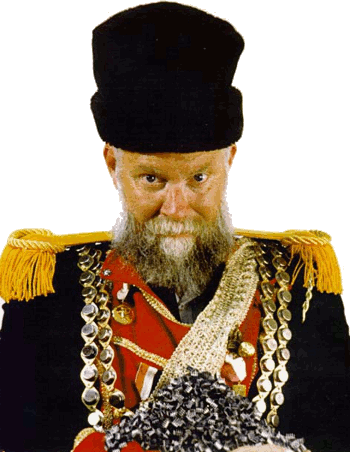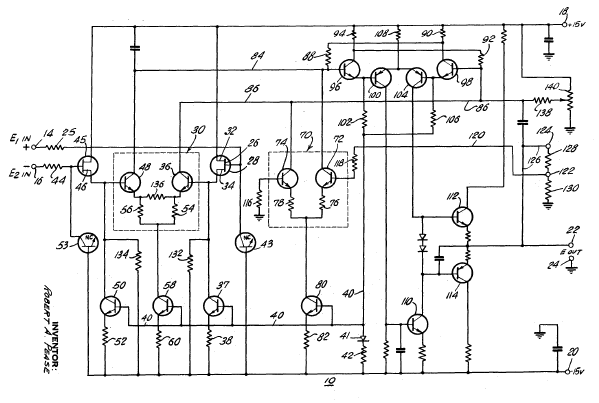Bob Pease
June 22, 2011
In today's world of
digital electronics, there are few
analog circuit designers. The world lost one of its best last Saturday (June 18, 2011) when
Robert A. (Bob) Pease died in a single car traffic accident at age 70 as he was returning from a memorial service for a friend and companion analog designer,
Jim Williams.[1] Since Pease was the author of a book on defensive driving,[2] I suspect that the cause of the accident wasn't unsafe driving on Bob's part, but a medical condition.[3] Not surprisingly, there have been many articles and many a reminiscence about Bob.[4-7]
In a
previous article (Unsafe at Any Speed, February 06, 2007), I mentioned how
Lev Landau,
Eugene (Gene) Shoemaker,
Seymour Cray,
Mary Ward,
Rudolf Karl Luneburg,
William Shockley,
Arnold Sommerfeld,
Max von Laue and
John Schrieffer all had unfortunate incidents involving
automobiles. Such safety problems, and the physical/environmental/political problems with fuel supply, make you wonder why we still persist in using such machines; or, more importantly, why more effort isn't devoted to better modes of transportation.
Pease earned a
BS degree in
electrical engineering from
MIT in 1961 and he joined
George A. Philbrick Researches, producer of the first mass-produced
operational amplifier, the
K2-W. In those days, of course, most electronics involved
vacuum tubes, and it was quite a feat designing a
temperature-stable DC amplifier.
The usual trick was to use a
mechanical chopper to turn the DC signal into an
alternating current for amplification by a simpler amplifier and then synchronously
detecting it on the other end. I have several examples of these soup-can-sized choppers in my collection, and they do not lend themselves to small, inexpensive devices. Philbrick's designs did not involve mechanical choppers. Click
here for the K2-W schematic diagram.
Bob was hired at Philbrick to bring operational amplifiers into the
solid state era, albeit with
discrete transistors and other discrete components. After honing his skills at Philbrick, Bob joined
National Semiconductor Corporation in 1976 as a designer of
monolithic analog circuits. His designs at National included the
LM331 voltage to frequency converter; and the
LM337 adjustable voltage regulator, which sold more than 135 million pieces.[4] He served also as an
applications engineer who designed
reference circuits around National's chips, and when he retired in 2009, he held the title of
staff scientist.

Bob Pease as the Czar of bandgap reference circuits.
(Via the Bob Pease Web Site at National Semiconductor)
The reason that Bob was so widely known in electrical engineering circles is his monthly column, called "Pease Porridge," in
Electronic Design Magazine. He started his column while he was at National, and he continued it after his retirement. Bob's column passed along a few analog circuit tricks, but it was also an eclectic mix of his favorite topics that included hiking and automotive tips. Richard Gawel, one of his editors, writes that "Sometimes I would expect a treatise on getting a better signal out of an analog-to-digital converter, and instead I'd get something on organizational systems for your refrigerator."[6] Bob also responded to reader's questions.
Bob and I exchanged emails on three topics over the years. Bob was, as they say, "customer-focused," and he thought that products should be the primary preoccupation of every industrial engineer. One of my emails suggested that you wouldn't have any new products if your company put too much emphasis on products and not enough on some
ivory tower thinking. Bob, in his usual, pull-no-punches, style, didn't subscribe to my philosophy.
When Bob wrote about scraping a file across an audio amplifier input,[9] I told him about my discovery in sixth grade when I wired a
file to large
battery and connected the other battery terminal through an
inductor to a wire lead. When I scraped the wire lead on the file, sparks would fly! Bob replied that " We didn't do much CONSTRUCTIVE design, back in the 8th grade. We didn't have many good parts - - like big inductors."
Then there was a trick that he taught me when I suggested that lamp cord would make good speaker wire if the amplifier and
loudspeaker were matched to the
transmission line impedance of the cord. After all, parallel conductors always have a characteristic impedance. Bob said that special amplifiers and speakers weren't required, since a parallel combination of several conductor pairs of a
ribbon cable, which is usually designed to have a 120-ohm impedance, would match anything.
Bob left National in 2009 at the same time the company announced a
layoff of 1,725 workers, so there was speculation that this may have been a forced retirement. National announced that Bob had retired, and that he would be retained as a consultant. Pease did not divulge the circumstances of his retirement.[4] Jim Williams, whose memorial service Bob had attended just before he died, said about Bob's retirement, "It's caused a terrific stir because the pope has left Rome. He is an icon across the entire breadth of the analog chip world." [4]
Bob Pease wrote more than 65 magazine articles, 190 magazine columns, and two books. He was a listed inventor on 21 U.S. patents.[8] A figure from one of his patents appears below.

Figure from US Patent No. 3,562,660, "Operational Amplifier," by Robert A. Pease (February 9, 1971).[10]
References:
- Mike Rosenberg, "Silicon Valley chip legend dies in Saratoga crash," Mercury News, June 21, 2011.
- Robert A. Pease, "How to Drive into Accidents - And How Not to," Pease Pub, December 1998, 472 pages (via Amazon).
- See, for example, the death of Harry Chapin.
- Mike Cassidy, "2009: Mike Cassidy column about chip-design legend Bob Pease," Mercury News, June 21, 2011. Also available at http://www.physorg.com/news159702678.html.
- Joseph Desposito, "Bob Pease Remembered For Pease Porridge And A Whole Lot More," Electronic Design, June 20, 2011.
- Richard Gawel, "An English Major Remembers An Analog Giant," Electronic Design, June 20, 2011.
- Don Tuite, "Remembering Bob Pease The Writer," Electronic Design, June 20, 2011.
- Ron Schneiderman, "Robert A. Pease: Passionate, Talented Guru And Maverick," Electronic Design, October 21, 2002.
- Bob Pease, "What's All This Merit Badge Stuff, Anyhow?" Electronic Design, December 8, 2004.
- Robert A. Pease, "Operational Amplifier," US Patent No. 3,562,660, February 9, 1971
Permanent Link to this article
Linked Keywords: Digital electronics; analog circuit; designer; Robert A. (Bob) Pease; Jim Williams; Lev Landau; Eugene (Gene) Shoemaker; Seymour Cray; Mary Ward; Rudolf Karl Luneburg; William Shockley; Arnold Sommerfeld; Max von Laue; John Schrieffer; automobile; BS degree; electrical engineering; MIT; George A. Philbrick Researches; operational amplifier; K2-W; vacuum tube; temperature-stable; DC amplifier; mechanical chopper; alternating current; synchronous detection; solid state; discrete transistor; National Semiconductor Corporation; monolithic; LM331 voltage to frequency converter; LM337 adjustable voltage regulator; applications engineer; reference circuit; staff scientist; bandgap reference; Electronic Design Magazine; ivory tower; file; battery; inductor; loudspeaker; transmission line; impedance; ribbon cable; layoff; US Patent No. 3,562,660.